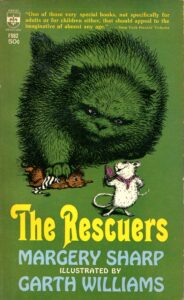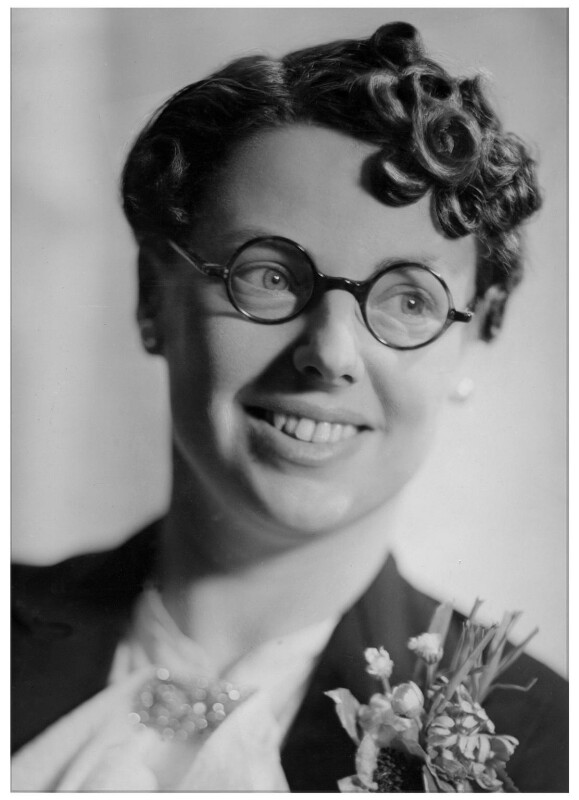Margery Sharp (1905-1991) was the best-selling writer, playwright and screenwriter of adult and children’s whimsical fiction who inspired the box office busting Disney film ‘The Rescuers’.
Early years and education
Clara Margery Melita Sharp was born in Salisbury in January 1905 to Yorkshire-born couple Clara and John Sharp. Her father was a Civil Servant in the War Office, briefly working in the Army Accounts Office. Shortly after Margery’s birth, the family left Hulse Road, Salisbury to go to Malta, where John was seconded. Here Margery attended the Chiswick House School[i]. Her interest in writing started early – she had planned to be a writer from the age of seven.
When Margery returned to the UK from Malta, she received a good education at Streatham Hill High School, with a distinction in English and English History and a Higher Certificate (1923). She worked briefly as a typist for a year, and then in 1925 she began attending Bedford College, University of London[ii]. She studied Intermediate Arts, then French with English. Her college career was devoted “almost entirely to journalism and campus activities.” This included story contributions to Punch magazine. She had a mentor in Sir Owen Seaman, the satirical Editor of Punch, who corresponded frequently with her and sent her letters encouraging her writing[iii]. She left the college in 1928 with a BA(Hons) Class II degree.
She then spent a year studying art at Westminster Art School, and it is clear from her books she had a passion and discipline for drawing and painting. While studying, she joined the National Students Union British University Women’s Debating Team, visiting Poland and Ireland. She was also chosen to be part of a team who visited American Women’s colleges all over the United States. The journey in 1928 by train and Steam ship with two other young women saw Margery mentioned in the press, including in the Sunday Mirror, and she also wrote about her tour experiences for the Evening Standard.
Writing and teaching career
After university Margery continued with her writing. She was disciplined and focused in her writing as well as researching her work meticulously. Her work drew on her own life experiences and locations she had lived in, for example part of her novel Sun in Scorpio was set in Malta. Although her work is known for being witty and comic in nature, she has also been praised for her characterisation and the complexity of her characters. The women characters in her books are striking in the way they are portrayed in relation to the changing societal norms of the time.
As well as her contributions to Punch magazine, her work was published in many other magazines including Encyclopaedia Britannica, Strand magazine, the Saturday Evening Post, the Ladies’ Home Journal, Harper’s, Woman’s Home Companion, Harper’s Bazaar, and Fiction Parade. She contributed mysteries to a Mystery and Adventure Stories for Girls, edited by Eric Duthie, and an Ellery Queen collection of mysteries. In addition, she also serialized novels in ladies’ magazines and newspapers, some of which had been released in instalments, before publication in hardbound book form. Margery set her goal at making £3 a week, this, apparently, came readily with the sale of one short story a month. Astonishingly, her first novel, Rhododendron Pie, only took her a month to write and was published in 1930, to critical acclaim.
Over her writing career, Margery wrote twenty-two novels in addition to novellas and stories. She also wrote fourteen children’s books and was a successful children’s book author. Her novels were best sellers, and she was successful in Britain and in America. The reviews of her books were alongside those by notable authors such as Harper Lee, Neville Shute, Agatha Christie, and Lewis Carroll. By 1972 most of her books were out of print, but a fan base persists, and reprints have been published recently.
Her adeptness for characterization and tight plotting made her work a natural fit for film and stage adaptation. Three of her novels — The Nutmeg Tree (1937), Cluny Brown (1944), and Britannia Mews (1946) —were made into feature films. In addition, Margery wrote or adapted numerous plays, including the 1962 comedy The Notorious Landlady, starring Jack Lemmon and Kim Novak, which was based on her short story called ‘The Notorious Tenant’. The Rescuers, written in 1959, was adapted into two Disney animated films[iv]. The plays were hugely popular and presented all over the country.
During the second world war, Margery spent 3 years serving as an Army Education Lecturer. It was a busy time: she travelled far, giving 10 talks a week and continuing with her writing, while maintaining a schedule of touring gun sites and searchlight posts.
She and her husband, Major Geoffrey Castle[v], lived a glamorous life, making frequent trips abroad including to New York and Brazil. They lived in various places including London, Lincolnshire, Lancashire, Oxford and Aldeburgh, Suffolk, where Margery lived in later life.


Legacy
Margery died in 1991 at Debden, Suffolk. She has left a legacy through her work, much of which has a timeless quality to it, and over the years she has had a dedicated readership, as well as people discovering her novels for the first time. She has been lauded for her ‘vision of the surprisingness of life, the breakability of rules, the spirit-cleansing power of the irrelevant’[vi]. In 2016, ten of her adult novels were released as e-book editions.
This profile was researched by Heather Sheeley and Brian Evans, and written by Heather Sheeley. Edits by S.Ali.
Photo of Margery Sharp by Howard Coster. Vintage bromide print, 1939. NPG X125020
© National Portrait Gallery, London. https://www.npg.org.uk/collections/search/portrait/mw57659/Margery-Sharp
Image of cover of Margery Sharp’s ‘The Rescuers’ https://www.flickr.com/photos/alittleblackegg/
Image of Blue Plaque by Jez Nicholson https://www.flickr.com/photos/jnicho02/
Sources:
Ancestry 1901 Census, Electoral Registers, England & Wales, Civil Registration Birth Index, 1837-1915 and Marriage Indexes, Immigration and Passenger Lists, 1939 Register, UK, British Army World War I Medal Rolls Index Cards, 1914-1920
British Newspaper Archives: The Salisbury Times 12 May 1905 P8; 26 May 1905 P8; The Sphere 27 October 1928 p23; Western Daily Press 15 October 1928 P13
Cambridge University Library: Department of Manuscripts and University Archives Add.8856/205-218 1926-28 Letters of Sir Owens Seaman.
Crawford, Elizabeth, 2021, Introduction; About the Author, Rhododendron Pie, by Margery Sharp. Kindle Edition, Dean Street Press.
Chiswick House School and St Martin’s College – Our History. https://www.chs.edu.mt/school-information/history/
Family Search England and Wales Marriage Register Index 1837-2005, 1871 Census
Findmypast Death Registration Index 1837-2007
Forgotten Authors No. 16: Margery Sharp
FreeBMD births
Harvard Library Harvard University MS Eng 1234-1234.22 literary MSS and papers 1928-1972
London England Royal Holloway ad Bedford College Student Registers 1849-1931. Pg 158
Margery Sharp, Witty British Novelist | LiteraryLadiesGuide
New York Times – The Enthusiast – In Praise of Margery Sharp. https://www.nytimes.com/2018/04/12/books/in-praise-of-margery-sharp.html
SFE The Encyclopaedia of Science fiction http://sf-encyclopedia.com/entry/castle_jeffery_lloyd
The Centre for Children’s ‘Books and Writers’ KW/04/03/10 broadcast script Seven Stories, Books 27 Sep 1946
The Margery Sharp Blog https://margerysharp.wordpress.com
Wikipedia: Margery Sharp, Geoffrey Lloyd Castle. https://en.wikipedia.org/wiki/Margery_Sharp
Publications
Novels
Rhododendron Pie (1930) only 1500 copies printed
Fanfare for Tin Trumpets (1932)
The Flowering Thorn (1934)
Four Gardens (1935)
The Nutmeg Tree (1937), which was made into the film Julia Misbehaves
Harlequin House (1939)
The Stone of Chastity (1940)
Three Companion Pieces (1941) – contains Sophy Cassmajor, The Tigress on the Hearth and The Nymph and the Nobleman
Cluny Brown (1944), which was made into a movie of the same title
Britannia Mews (1946), which was made into the film The Forbidden Street
The Foolish Gentlewoman (1948)
Lise Lillywhite (1951)
The Gipsy in the Parlour (1954)
The Eye of Love (1957) – Martha Trilogy I
Something Light (1960)
Martha in Paris (1962) – Martha Trilogy II
Martha, Eric, and George (1964) – Martha Trilogy III
The Sun in Scorpio (1965)
In Pious Memory (1967)
Rosa (1969)
The Innocents (1972)
The Faithful Servants (1975)
Summer Visits (1977)
Stories and novellas (selected)
The Nymph and The Nobleman (1932)
Sophy Cassmajor (1934)
The Tigress on the Hearth (1955)
The Lost Chapel Picnic and Other Stories (1973)
Children’s novels
Melisande (1960)
Lost at the Fair (1965)
The Magical Cockatoo (1974)
The Children Next Door (1974)
The Rescuers series
The Rescuers (1959)
Miss Bianca (1962)
The Turret (1963)
Miss Bianca in the Salt Mines (1966)
Miss Bianca in the Orient (1970)
Miss Bianca in the Antarctic (1971)
Miss Bianca and the Bridesmaid (1972)
Bernard the Brave (1977)
Bernard into Battle (1978)
Stage and film adaptations
The Lady in Waiting (Broadway show, 1940; adapted from The Nutmeg Tree)
Cluny Brown (1946) In 1946, it had sold 1,310,160 copies in America alone.
Julia Misbehaves (film adaptation of The Nutmeg Tree, 1948)
The Forbidden Street (film adaptation of Britannia Mews, 1949)
“The Notorious Tenant” (1956), short story on which the movie The Notorious Landlady was based
The Rescuers (animated film, 1977)
The Rescuers Down Under (animated film, 1990)
Plays
Meeting at Night produced London, 1934 Lady in Waiting (adaptation of her novel ‘The Nutmeg Tree’) produced New York at the Martin Beck Theatre, March,1940; London, 1941; also performed in French, NY 1941. Produced by Brock Pemberton, directed by Antoinette Perry
The Foolish Gentlewoman (adaptation of her novel of same name) produced London, 1949, at the
Duchess Theatre; starring Sybil Thorndike; also produced in French, London, 1950
The Birdcage Room television play, 1954
Miscellaneous Works
‘The Portrait’ A mystery story found in the anthology of horror/mystery ‘In the Dead of Night’–edited by Michael Sissons, published 1961 London, Gibb, and Phillips.
“Risk” Published 1942 in ‘Third Omnibus of Crime’, edited by Dorothy Sayers, Publisher Coward MacCann, Inc. Reprinted in MYSTERY AND ADVENTURE STORIES FOR GIRLS edited by Eric Duthie. Published 1962, London, Odhams
“On the Lake” Harper’s magazine, 1937
Notes
[i] This school was originally created for children of British families stationed in Malta.
[ii] Bedford College was founded by social reformer and anti-slavery activist Elizabeth Jesser Reid, and at the time it was part of the University of London. Eventually it merged with the Royal Holloway College.
[iii] Letters to Margery Sharp are archived with Cambridge University Library. Series Reference Code: GBR/0012/MS Add.8856/205-218
https://archivesearch.lib.cam.ac.uk/repositories/2/archival_objects/549357
[iv] The Rescuers released in 1977, and the sequel ‘Rescuers down under’ was released in 1990.
[v] In 1938 she married Major Geoffrey Lloyd Castle, RFA,RFC, and RA, who was an aeronautical engineer, one-time journalist and writer of early science fiction.
[vi] As written by Clifton Fadiman, American intellectual, author and TV personality. https://margerysharp.wordpress.com/an-overview-of-her-work/

